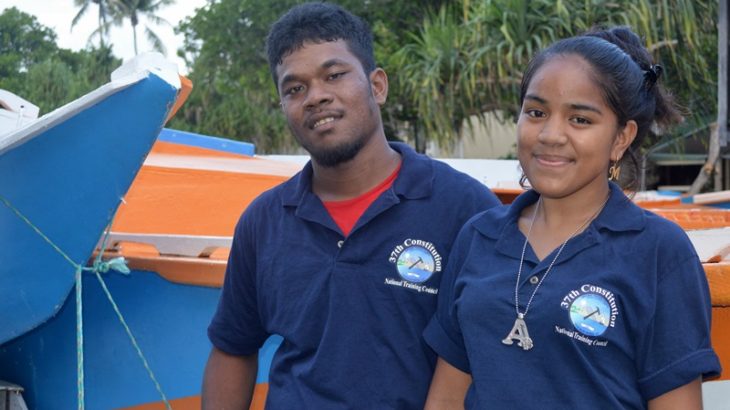On having women involved in the WAM training program, Director Alson Kelen said:
We went to the Council of Chiefs and they did not need to stop and think about it, because they understood that everyone in the community has a task to do when making and sailing a canoe. It doesn’t matter if it’s building a house, going fishing or making a canoe … everyone has a role, including the women.
By Karen Earnshaw
Taula Milne’s education began at Rita Elementary School and continued on to Majuro Middle School. And that’s it. Done. The End.
Until, that is, he heard about the Waan Aelon in Majel (Canoes of the Marshall Islands) 2016 training program and signed up. “I came to WAM to finish school,” he said. “I’m learning to build a canoe and be a carpenter. And learning to sail a canoe … it’s great.”
Taula is one of 25 trainees now half way through their six-month WAM vocational program, which began as a wonderful cultural concept of reviving the art of canoe building over 30 years ago.
In all those years, WAM has passed many milestones, and last Monday evening was no exception. “For the first time ever, we’re holding an open house at WAM,” said Director Alson Kelen shortly before the event. Associate Director Tamie Bowman continued: “Alson is always emphasizing how important the trainees’ mentors are, be it their parents or a friend or simply someone they look up to. We were reaching the middle of the program and we decided to invite these mentors’ to WAM, to show them what we are doing and seek their help in supporting the trainees.”
And so at 5pm on Monday, families and friends of the trainees and the program gathered in WAM’s headquarters/school room next to Ministry of Education. The keynote speaker was Allison Nashion, head of the RMI National Training Council (NTC), which is the main source of funding for the program. “WAM fills many of the focus training areas that are important to NTC, with the goal being to give them a sustainable livelihood,” he said. As part of this goal, Allison said that NTC is a source of employment information for graduates of all the programs it supports. “Job seekers can come to our office, which is in the tall building opposite Marshall Islands Resort, and we can help them with resumes and prepare them for job interviews. We can also help them look for advanced training at places such as Job Corps in Hawaii.” He added that currently there are over 100 Marshallese students in the Job Corps program in Honolulu and Maui, Hawaii.
Following Allison’s speech, two students made remarks on behalf of all the trainees. First up was Etri John, who confidently read his speech, which touched on the many aspects of the training. “It has helped us learn many new things: not only how to work, but also about ourselves.” After the energetic applause for the speech, which he gave in English, subsided, Director Alson had a big grin on his face as he told the audience that when he’d first met Etri, the youngster could not look up and meet his eye, let alone speak before a room full of people. “He’s made great progress!”
The second student speaker was Mary Ann Kiluwe, who also delivered her speech, this time in Marshallese, which was also followed by a robust round of clapping.
On congratulating Mary for her moments at the podium, Alson added: “From the first days of the program, we have always been keen to include women, which brought a lot of comments from the community. People said to us, ‘Is this the Marshallese custom or is it UN (United Nations) custom?’ So we went to the Council of Chiefs and they did not need to stop and think about it, because they understood that everyone in the community has a task to do when making and sailing a canoe. It doesn’t matter if it’s building a house, going fishing or making a canoe … everyone has a role, including the women.”
In recent weeks, a group of the trainees has been working on making a new design for the WAM T-shirts and on behalf of the artists, Scamyo Namdrik told the audience how much they had enjoyed the process.
Following the speeches the audience was invited to visit the big A-frame Canoe House and view the cunning miniature canoes that have long been a signature product of WAM and the construction of two full-size sailing canoes. Also on display were a series of pandanus pounders and strippers the students are making for the jaki-ed revival program at the University of the South Pacific.
Clearly, the WAM trainees have been busy … and will continue to be as they move forward to a brighter future.








